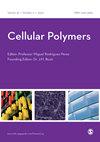Cellular Morphology Optimization of Polypropylene/CaCO3 Composite Films Designed for Piezoelectric Applications
IF 1.9
4区 医学
Q4 MATERIALS SCIENCE, BIOMATERIALS
引用次数: 5
Abstract
In this work, the cellular morphology of polypropylene (PP)/calcium carbonate (CaCO3) composite films was optimized with respect to piezoelectric cellular films criteria. To do this, a series of PP films filled with CaCO3 micro-particles of three different particle sizes (3, 6 and 12 microns) were developed at various weight concentrations (3 to 44 wt. %). Before going through a gas diffusion expansion (GDE) step to inflate the initiated cells, all composite films were first produced via extrusion/calendaring then biaxially stretched to initiate the cellular structure by interfacial delamination between the CaCO3 particles and PP matrix. After biaxial stretching and GDE, it was observed that only films with filler contents above 23 wt.% and 12 μm particle size presented a well-developed cellular structure. By optimizing the extrusion, biaxial stretching and GDE steps, we were able to generate a required cellular morphology where the average cell height ranged between 5 and 8 μm, which is considered good for further Corona charging. Also, the average cell aspect ratio (cell length divided by cell height) ranged between 4 and 10 with an average cell wall thickness between 7 and 12 μm, which is also considered as optimum for good piezoelectric properties.压电型聚丙烯/CaCO3复合薄膜的细胞形态优化
在这项工作中,聚丙烯(PP)/碳酸钙(CaCO3)复合膜的细胞形态根据压电细胞膜的标准进行了优化。为了做到这一点,在不同的重量浓度(3至44 wt. %)下,开发了一系列充满三种不同粒径(3、6和12微米)的CaCO3微粒的PP薄膜。在通过气体扩散膨胀(GDE)步骤膨胀初始细胞之前,所有复合膜首先通过挤压/压延生产,然后通过CaCO3颗粒和PP基体之间的界面分层进行双轴拉伸,以初始化细胞结构。经过双向拉伸和GDE后,发现只有填料含量大于23 wt.%、粒径大于12 μm的薄膜才呈现出发育良好的细胞结构。通过优化挤压、双轴拉伸和GDE步骤,我们能够生成所需的电池形态,电池的平均高度在5到8 μm之间,这被认为有利于进一步的电晕充电。此外,电池的平均宽高比(电池长度除以电池高度)在4到10之间,平均壁厚在7到12 μm之间,这也被认为是良好压电性能的最佳选择。
本文章由计算机程序翻译,如有差异,请以英文原文为准。
求助全文
约1分钟内获得全文
求助全文
来源期刊

Cellular Polymers
工程技术-材料科学:生物材料
CiteScore
3.10
自引率
0.00%
发文量
9
审稿时长
3 months
期刊介绍:
Cellular Polymers is concerned primarily with the science of foamed materials, the technology and state of the art for processing and fabricating, the engineering techniques and principles of the machines used to produce them economically, and their applications in varied and wide ranging uses where they are making an increasingly valuable contribution.
Potential problems for the industry are also covered, including fire performance of materials, CFC-replacement technology, recycling and environmental legislation. Reviews of technical and commercial advances in the manufacturing and application technologies are also included.
Cellular Polymers covers these and other related topics and also pays particular attention to the ways in which the science and technology of cellular polymers is being developed throughout the world.
 求助内容:
求助内容: 应助结果提醒方式:
应助结果提醒方式:


